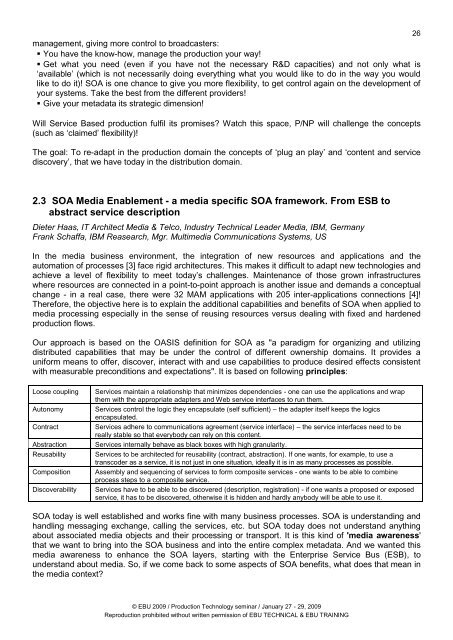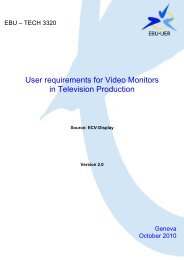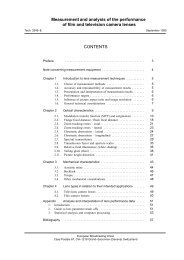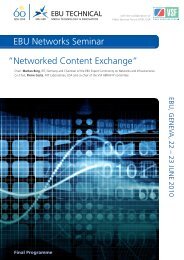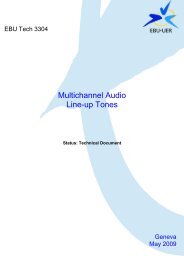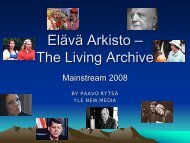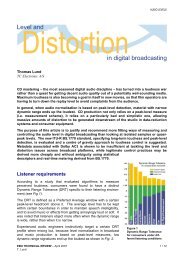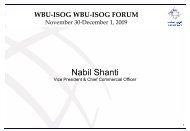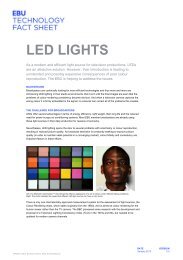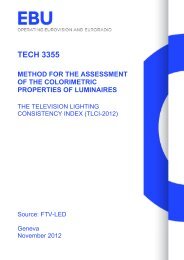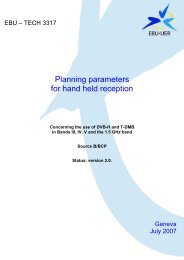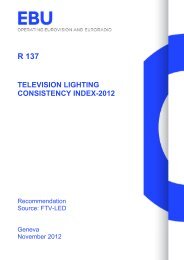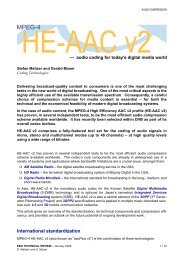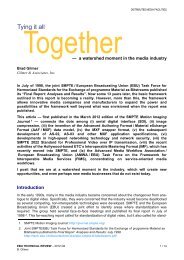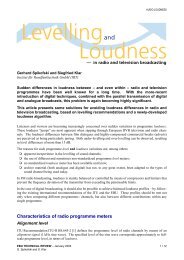Production Technology Seminar 2009 - EBU Technical
Production Technology Seminar 2009 - EBU Technical
Production Technology Seminar 2009 - EBU Technical
Create successful ePaper yourself
Turn your PDF publications into a flip-book with our unique Google optimized e-Paper software.
26<br />
management, giving more control to broadcasters:<br />
� You have the know-how, manage the production your way!<br />
� Get what you need (even if you have not the necessary R&D capacities) and not only what is<br />
„available‟ (which is not necessarily doing everything what you would like to do in the way you would<br />
like to do it)! SOA is one chance to give you more flexibility, to get control again on the development of<br />
your systems. Take the best from the different providers!<br />
� Give your metadata its strategic dimension!<br />
Will Service Based production fulfil its promises? Watch this space, P/NP will challenge the concepts<br />
(such as „claimed‟ flexibility)!<br />
The goal: To re-adapt in the production domain the concepts of „plug an play‟ and „content and service<br />
discovery‟, that we have today in the distribution domain.<br />
2.3 SOA Media Enablement - a media specific SOA framework. From ESB to<br />
abstract service description<br />
Dieter Haas, IT Architect Media & Telco, Industry <strong>Technical</strong> Leader Media, IBM, Germany<br />
Frank Schaffa, IBM Reasearch, Mgr. Multimedia Communications Systems, US<br />
In the media business environment, the integration of new resources and applications and the<br />
automation of processes [3] face rigid architectures. This makes it difficult to adapt new technologies and<br />
achieve a level of flexibility to meet today‟s challenges. Maintenance of those grown infrastructures<br />
where resources are connected in a point-to-point approach is another issue and demands a conceptual<br />
change - in a real case, there were 32 MAM applications with 205 inter-applications connections [4]!<br />
Therefore, the objective here is to explain the additional capabilities and benefits of SOA when applied to<br />
media processing especially in the sense of reusing resources versus dealing with fixed and hardened<br />
production flows.<br />
Our approach is based on the OASIS definition for SOA as "a paradigm for organizing and utilizing<br />
distributed capabilities that may be under the control of different ownership domains. It provides a<br />
uniform means to offer, discover, interact with and use capabilities to produce desired effects consistent<br />
with measurable preconditions and expectations". It is based on following principles:<br />
Loose coupling Services maintain a relationship that minimizes dependencies - one can use the applications and wrap<br />
them with the appropriate adapters and Web service interfaces to run them.<br />
Autonomy Services control the logic they encapsulate (self sufficient) – the adapter itself keeps the logics<br />
encapsulated.<br />
Contract Services adhere to communications agreement (service interface) – the service interfaces need to be<br />
really stable so that everybody can rely on this content.<br />
Abstraction Services internally behave as black boxes with high granularity.<br />
Reusability Services to be architected for reusability (contract, abstraction). If one wants, for example, to use a<br />
transcoder as a service, it is not just in one situation, ideally it is in as many processes as possible.<br />
Composition Assembly and sequencing of services to form composite services - one wants to be able to combine<br />
process steps to a composite service.<br />
Discoverability Services have to be able to be discovered (description, registration) - if one wants a proposed or exposed<br />
service, it has to be discovered, otherwise it is hidden and hardly anybody will be able to use it.<br />
SOA today is well established and works fine with many business processes. SOA is understanding and<br />
handling messaging exchange, calling the services, etc. but SOA today does not understand anything<br />
about associated media objects and their processing or transport. It is this kind of 'media awareness'<br />
that we want to bring into the SOA business and into the entire complex metadata. And we wanted this<br />
media awareness to enhance the SOA layers, starting with the Enterprise Service Bus (ESB), to<br />
understand about media. So, if we come back to some aspects of SOA benefits, what does that mean in<br />
the media context?<br />
© <strong>EBU</strong> <strong>2009</strong> / <strong>Production</strong> <strong>Technology</strong> seminar / January 27 - 29, <strong>2009</strong><br />
Reproduction prohibited without written permission of <strong>EBU</strong> TECHNICAL & <strong>EBU</strong> TRAINING


